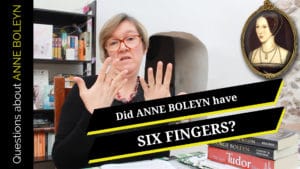 The question “Did Anne Boleyn have six fingers?” always makes me smile, although I know that the asker means six fingers on one hand!
The question “Did Anne Boleyn have six fingers?” always makes me smile, although I know that the asker means six fingers on one hand!
The idea that Anne Boleyn had an extra finger is so prevalent. I see it coming up all the time on social media and it also appears in historical novels, as well as some non-fiction books.
In the latest instalment of my series answering Anne Boleyn Files followers questions on Anne and her family, I examine the origin of this idea and whether it has any basis in history. I do hope you’re enjoying these videos.
In the video, I also mention the idea that Anne Boleyn miscarried a deformed foetus in 1536. You can find out more about that myth in my video Did Anne Boleyn miscarry a deformed foetus? at https://youtu.be/bNb473eMt8U.
Note: Yes, for some unknown reason, I say 29 years instead of 49 years! I can’t even blame the birthday cava as I drank that later! Sorry!
If you’re interested in finding out more about the exhumation of Anne Boleyn’s remains at the Chapel of St Peter ad Vincula, you can read the following articles: